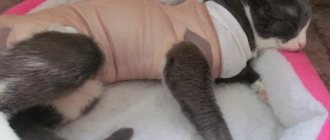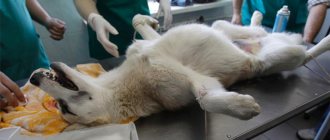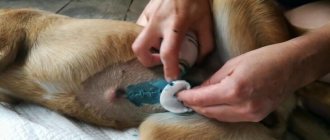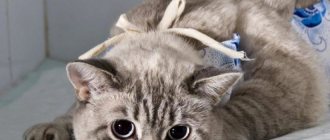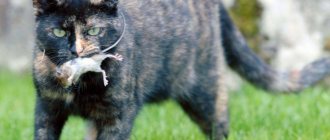When is anesthesia used for dogs?
Anesthesia is an artificially induced, reversible condition characterized by the following symptoms:
- loss of consciousness, artificial sleep, amnesia occurs;
- the muscles relax, natural reflexes are completely or partially switched off, the dog is immobilized;
- The nerve endings do not perceive pain, and complete pain relief occurs in the animal’s body.
At the veterinarian's appointment
Indications for the use of general anesthesia for dogs:
- Carrying out abdominal operations.
- Operations on the limbs and head.
- Ear and tail docking.
- Castration.
- X-ray.
- Taking a histology analysis.
- Endoscopic examination.
- Dental treatment, cleaning tartar.
- The animal is or may be aggressive.
- Inability to fix the desired body position when the animal is conscious.
Anesthesia can be intravenous, intramuscular or inhalational. The type of anesthesia is prescribed by the doctor depending on the complexity, duration of the surgical intervention or manipulation, health status, weight, and age of the dog.
Important! Before administering anesthesia, the veterinarian examines the dog: a blood test, assessment of the condition of the heart, lungs, ultrasound of internal organs, MRI. The owner is warned about possible risks and complications. He gives written consent to the operation and other necessary manipulations.
Inhalation anesthesia
Complications after anesthesia in dogs
Carrying out anesthesia entails certain risks for the animal's body. Except in cases of emergency surgery, animals that do not have severe concomitant uncompensated diseases are allowed for surgical intervention. Before undergoing surgery or x-rays that require sedation, dogs undergo a pre-anesthesia examination. To assess the risks of anesthesia, the animal is examined, a medical history is taken, general clinical and biochemical blood tests are performed, and an ultrasound examination of the heart is performed. If deviations are detected at any stage of the preoperative examination, additional methods of monitoring the dog’s health will be proposed. If surgical intervention is possible at a later date, then the identified concomitant diseases are treated first. In cases where serious contraindications to anesthesia are discovered, the feasibility of surgery is assessed and alternative treatment methods are developed.
How long does it take for a dog to recover from anesthesia after surgery?
The dog's recovery from anesthesia is an important moment when the animal's condition must be monitored by an anesthesiologist or veterinarian in a hospital setting. The safest in terms of possible control and minor complications are inhalation and intravenous anesthesia. Intramuscular anesthesia is difficult to control. It has many side effects. Therefore, a competent veterinarian rarely uses it.
How long does it take for a cat to recover from anesthesia after sterilization: how you can help
The effect of inhalation anesthesia continues as long as the dog inhales the gas mixture. She quickly falls into a sleep state and awakens within a few minutes after the drug wears off. It is often combined with the administration of analgesics.
With intravenous anesthesia, the animal falls asleep within a minute. The duration of action depends on the amount of medicine administered. To bring her to consciousness earlier, special drugs are administered to awaken and restore her.
Important! The speed at which a dog comes to its senses after anesthesia depends on its state of health and the complexity of the operation. This may take from a few minutes to several hours.
Dog after anesthesia
After the operation is completed, the dog is placed in a hospital to monitor its recovery from anesthesia. At this time, the animal cannot control its behavior, is disoriented, and weakened. During epidural anesthesia, the dog cannot use its hind legs for some time, so it is necessary to limit its movement so that the pet cannot injure itself.
While the dog is in the postoperative hospital, if necessary, it undergoes thermometry and additional warming (cooling) in order to reduce postoperative pain and prevent swelling. In addition, the animal is supplied with oxygen and painkillers are administered. After the veterinarian is convinced that the dog’s life is not in danger, it is discharged from the hospital and the pet can be taken home.
The first day after surgery: recovery from anesthesia
How long do cats recover from anesthesia after castration: how long can they sleep?
This period is very important for the pet's health. Recovery time depends on the individual characteristics of the animal. It is important to know how dogs recover from anesthesia. It may take from 2-3 hours to a day before the pet comes to its senses.
Ideally, all this time the dog should be in a stationary clinic under the supervision of an experienced veterinarian. In reality, the animal is handed over to the owner almost immediately after waking up. He has to see and worry about his pet if side symptoms occur:
- Dizziness, unsteady gait, whining.
- The dog does not get up, twitches its paws, falls on its side, and cannot walk.
- Lack of appetite, reaction to nicknames.
- Vomiting occurs.
- The dog is shaking after anesthesia.
- Fright, fear of people, and aggression appear.
All of the above symptoms are considered normal if they last no more than a day after surgery. During this period, the pet needs to be kept at rest and periodically moisten its lips with water. If these symptoms continue for more than a day, you should immediately seek veterinary help.
Dog after surgery
First aid
First of all, it is necessary to quickly eliminate external factors: stress, heat, anxiety. You should provide the dog with a comfortable environment. It is necessary to create good ventilation in the room where the pet will lie. In order not to aggravate the situation, you should not lift the animal’s head and forcefully feed it water. If the temperature is high, you can apply ice.
If the dog begins to choke, tremble and cough, you should resort to an oxygen mask. If your tongue turns blue, which is a sign of heart failure, you should place heating pads on your dog's paws. But if breathing is not restored, you should immediately show the dog to a veterinarian. Tachypnea cannot be ignored, since the frequency of respiratory movements does not always return to normal on its own.
When is rapid breathing normal?
Normal breathing rate:
- in an adult dog – 10-30 breaths/min,
It all depends on the sex, age and size (weight) of the animal. There are a great many reasons why dogs begin to breathe frequently, and this is not a pathology. Moreover, animals are also subject to emotional experiences and stress, which cannot but affect their general condition.
Pets breathe more often due to breed characteristics or from:
- fear, rage or joy;
- travel in transport and indoors in an unfamiliar place;
- visits to the veterinarian, unpleasant manipulations (after surgery or after vaccination) or from the administration of certain medications;
- physiological changes in the body (estrus, pregnancy, childbirth);
- increased activity and games, walks, physical activity, fatigue;
- eating;
- overheating
All of these factors do not threaten the life and health of animals and are physiologically compensated - after the causes cease, the respiratory rate returns to normal.
Anesthesia drugs used
Caring for your dog after sterilization at home
The choice of drug depends on the complexity and timing of the procedure, surgery and the individual characteristics of the dog. Previously, anesthesiologists used medications that had “severe” side effects. Modern drugs are softer and safer:
- For inhalation anesthesia, Xenon, Isoflurane, and Sevoflurane are used.
- For a strong analgesic effect, anesthesia is administered intravenously. These are “Butorphanol”, “Domitor”.
- Intravenous drugs of weak and short-term action - “Doprivan”, “Propofol”. They provide quick awakening and “mild”, short-term side effects.
What to do during the recovery phase
The recovery phase of a dog’s body after surgery can last from 10 days to 2 months. Its duration depends on the complexity of the operation, age, and immunity of the animal. When the pet comes to its senses, all care for it falls on the shoulders of the owner. The attending physician must provide advice on care during the recovery period.
Important! The owner must carefully look after a sick dog, showing care and affection. This will speed up her recovery.
General rules of care during the recovery period:
- Provide your pet with absolute rest on soft bedding and no drafts. The first day after anesthesia, the dog usually lies down and does not get up.
- For the first 6-7 hours, the animal is not allowed to drink, but only its lips are moistened. Then you can place a bowl of water nearby or drink from a syringe with the needle removed.
- You cannot feed your pet for 12-24 hours after surgery. Then you can give light food: broths, soaked dry food, wet food. Portions should be slightly smaller than usual.
- If a dog is trembling after anesthesia, has slight tremors and cold paws, it should be covered with a blanket or a warm blanket.
- Measure your temperature twice a day: morning and evening. On the second day it should return to normal - from 37.5 to 39.4 degrees.
- Clean up after your dog if he goes to the toilet. During the first days, walking outside is prohibited.
- Give pain relief so she can recover from anesthesia faster and sleep more.
- After removal of the uterus, sterilization or other abdominal operations, a blanket or bandage is put on the dog, protecting the surgical suture from infection and dehiscence. The seam is treated with antiseptics, and the bandage is changed daily to a sterile one.
Inflammation of surgical sutures
Treatment
If during the diagnostic process it was revealed that seizures are a consequence of brain disorders, then treatment is started only if the animal’s condition is alarming. The owner must keep a detailed diary - the data from it will help determine whether the disease is progressing and whether the therapy prescribed by the veterinarian is helping. This information is vital.
Drugs
The drugs used in treatment are usually classified as potent. And each animal reacts to them differently. In addition, it is often necessary to try many treatment options until the most suitable one is found.
Note that during the therapeutic course, dogs often become sleepy. This is easily explained, since severe seizures are usually treated with phenobarbital and potassium bromide (KBr), used alone or in combination with each other. It is possible to prescribe Primidone, Gabapentin, clonazepam. The appointment time cannot be changed.
When using potent compounds, the animal should be examined regularly by a veterinarian. Only a veterinarian can give a command to stop or change therapy. It should be remembered that even a planned dose reduction can cause a relapse. In order to maintain the animal’s quality of life at a high level, in case of pathologies caused by damage to the central nervous system, medications will have to be given for life.
To relieve prolonged and severe attacks, it is advisable to administer Valium or a similar drug. Phenobarbital and other potent neuroleptics often have a toxic effect on the animal’s liver.
For this reason, at least once a quarter, a full medical examination should be carried out with a mandatory check of blood biochemistry (checking the level of liver enzymes). If the level of the latter is elevated, increasing the dosage is prohibited.
In some cases, it is necessary to continue using potent drugs even if the liver is damaged.
In such situations, it is necessary to choose a therapeutic strategy in order to reduce the number of attacks and reduce their duration. The dosage is selected empirically, since the body of animals, let us remind you, reacts differently to medications. It is necessary to achieve such a result that attacks do not recur for at least three months.
Once again we remind you of the importance of keeping a detailed diary. Data from it will help veterinarians adjust therapy if necessary. Of course, you are unlikely to be able to watch your pet every minute, but the diary is still extremely useful.
Prevention
It is much simpler when convulsive phenomena are in no way related to pathologies of the central nervous system. The therapeutic course in such cases depends on the identified underlying causes. Thus, for liver pathologies, hepatoprotectors are prescribed, infectious diseases are treated by prescribing loading doses of broad-spectrum antibiotics.
If your dog faints from the heat and stuffiness, take care of a normal ventilation system and do not go out with him for a walk on hot summer days. To minimize the likelihood of postpartum eclampsia, feed your animal high-quality, balanced food. Finally, take your pet to the vet at least quarterly. A quality examination of the animal will not hurt under any circumstances.
What should alert the owner
The way a dog behaves after anesthesia indicates how easy the recovery period is for it. The owner should be wary of the following points:
- The dog is breathing heavily after anesthesia, wheezing, coughing. A complication may occur if the pet has problems with the respiratory and cardiovascular systems.
- Irritation, allergies, and swelling occurred at the operation site. It may be necessary to replace the antiseptic, medications, or prescribe antihistamines.
- Constipation, lack of urination 2-3 days after surgery. The pet must be urgently shown to the veterinarian and the feeding changed.
- The dog vomits after anesthesia for several days.
What is this. Kinds
Cramps are muscle contractions uncontrolled by consciousness, varying in prevalence, duration and intensity, which are paroxysmal in nature.
Seizures are a clinical symptom, not a specific disease. According to the degree of spread throughout the body, cramps are divided into:
- Generalized – symmetrical convulsions affecting both halves of the body, while the dog is in an altered state of consciousness.
- Focal (also called focal or partial) - seizures affect only one side of the body, they can be limited to one area of the head or body, very often go unnoticed, and can be with or without loss of consciousness.
Focal convulsions with secondary generalization may also occur, that is, first convulsions occur in one part of the body, and then spread to the entire body and become generalized.
Based on the form of muscle contractions, cramps are divided into:
- Clonic (rare) - manifests itself as intense muscle contractions, usually of the muzzle or limbs.
- Tonic (rare) - manifested by prolonged muscle tone, tense extension of the limbs and spine, which often causes the head to be thrown back; this position of the dog with straightened limbs and thrown back head is called opisthotonus.
- Tonic-clonic (most common) is an alternation of tonic and clonic periods, and symptoms such as dilated pupils, drooling, involuntary bowel movements and urination can often occur.
- Myoclonic (rare) are muscle contractions of one muscle or one muscle group, most often observed on the head, neck and thoracic limbs.
When is an urgent need to contact a veterinarian?
Despite excellent home care, complications in the postoperative period are possible. Ignoring some symptoms can lead to serious consequences or death for your pet. Here are the main ones:
- high body temperature on the 2nd day after surgery;
- suppuration or divergence of the surgical suture;
- bleeding;
- weak intermittent breathing;
- clouding of consciousness, cyanosis of the mucous membranes;
- wheezing, cough, shortness of breath.
Important! In case of any suspicious symptoms, in order to preserve the life and health of your pet, you should immediately contact a veterinary clinic.
After vaccination
Often, after canine injections, dogs begin to experience a convulsive heart rhythm or tachycardia. These processes are accompanied by tachypnea. If it is difficult for an animal to inhale and exhale normally immediately after vaccination, the first thing you need to understand is that this is not an allergy. It can lead to anaphylactic shock and cause death. Therefore, it is necessary to stay with your pet in the clinic for half an hour after the procedure.
If a dog is breathing spasmodically several hours after vaccination, this means that the immune system has responded to the vaccine. In this case, a high breathing rate may be accompanied by loss of appetite, decreased activity, indigestion and fever. Typically, respiratory function returns to normal within 24 hours.

